At this stage, specific short-term price points are used to indicate when minor wave 4 may have arrived.
Summary: At this stage, it is possible that minor wave 3 could be over. Confidence in this view is required with a new low below 3,212.03.
If price continues higher, then the next target would be at 3,289.
Three large pullbacks or consolidations (fourth waves) during the next 1-2 years are expected: for minor wave 4 (coming soon, possibly tomorrow), then intermediate (4), and then primary 4. Extreme conditions warrant more careful attention to risk management at this time.
The biggest picture, Grand Super Cycle analysis, is here.
Monthly charts were last published here, with video here. There are two further alternate monthly charts here, with video here.
ELLIOTT WAVE COUNTS
The two weekly Elliott wave counts below will be labelled First and Second. They may be about of even probability. When the fifth wave currently unfolding on weekly charts may be complete, then these two wave counts will diverge on the severity of the expected following bear market. To see an illustration of this future divergence monthly charts should be viewed.
FIRST WAVE COUNT
WEEKLY CHART
The basic Elliott wave structure consists of a five wave structure up followed by a three wave structure down (for a bull market). This wave count sees the bull market beginning in March 2009 as an incomplete five wave impulse and now within the last fifth wave, which is labelled cycle wave V. This impulse is best viewed on monthly charts. The weekly chart focusses on the end of it.
Elliott wave is fractal. This fifth wave labelled cycle wave V may end a larger fifth wave labelled Super Cycle wave (V), which may end a larger first wave labelled Grand Super Cycle wave I.
The teal Elliott channel is drawn using Elliott’s first technique about the impulse of Super Cycle wave (V). Draw the first trend line from the end of cycle wave I (off to the left of the chart, the weekly candlestick beginning 30th November 2014) to the end of cycle wave III, then place a parallel copy on the end of cycle wave II. This channel perfectly shows where cycle wave IV ended at support. The strongest portion of cycle wave III, the end of primary wave 3, overshoots the upper edge of the channel. This is a typical look for a third wave and suggests the channel is drawn correctly and the way the impulse is counted is correct.
Within Super Cycle wave (V), cycle wave III is shorter than cycle wave I. A core Elliott wave rule states that a third wave may never be the shortest. For this rule to be met in this instance, cycle wave V may not be longer in length than cycle wave III. This limit is at 3,477.39.
Cycle wave V may subdivide either as an impulse or an ending diagonal. Impulses are much more common. An alternative wave count which considered an ending diagonal has been invalidated. While it is possible a diagonal may become an alternate wave count in coming weeks or months, at this stage the structure does not fit.
At this stage, cycle wave V may take another one to two or so years to complete.
The daily chart below will focus on movement from the end of intermediate wave (2) within primary wave 3.
In historic analysis, two further monthly charts have been published that do not have a limit to upwards movement and are more bullish than this wave count. Members are encouraged to consider those possibilities (links below summary) alongside the wave counts presented on a daily and weekly basis. It is my judgement that the two weekly wave counts published in this analysis have the highest probability, so they shall be the only wave counts published on a daily basis.
Within cycle wave V, primary waves 1 and 2 may be complete. Within primary wave 3, intermediate waves (1) and (2) may be complete. Within the middle of intermediate wave (3), no second wave correction may move beyond its start below 2,855.96.
DAILY CHART
All of primary wave 3, intermediate wave (3) and minor wave 3 may only subdivide as impulses.
Minor wave 3 has passed 1.618 the length of minor wave 1, and within it minute wave v has passed equality in length with minute wave i. The next target may be now about 3,289 where minuette wave (v) within minute wave v would reach 1.618 the length of minuette wave (i).
Minor wave 2 was a sharp deep pullback, so minor wave 4 may be expected to be a very shallow sideways consolidation to exhibit alternation. Minor wave 2 lasted 2 weeks. Minor wave 4 may be about the same duration, or it may be a longer lasting consolidation. Minor wave 4 may end within the price territory of the fourth wave of one lesser degree; minute wave iv has its range from 3,154.26 to 3,070.49.
Minor wave 4 may not move into minor wave 1 price territory below 3,021.99.
Intermediate wave (3) has now moved far enough above the end of intermediate wave (1) to allow intermediate wave (4) to unfold and remain above intermediate wave (1) price territory.
Draw an acceleration channel now about intermediate wave (3): draw the first trend line from the end of minor wave 1 to the last high, then place a parallel copy on the end of minor wave 2. Keep redrawing the channel as price makes new highs. Minor wave 4 may find support at the lower edge of this channel if it is long lasting or deep enough.
Price is approaching the upper edge of the wide teal channel copied over from monthly and weekly charts. If price gets up to this trend line, then a reaction downwards there would be highly likely.
HOURLY CHART
It is possible that minor wave 3 may be close to completion.
This best fit channel is redrawn to contain all upwards movement; it has been slightly adjusted to be as conservative as possible. If this channel is breached, then that may be taken as an indication that minor wave 4 may have arrived.
Within minuette wave (v), subminuette wave ii may not move beyond the start of subminuette wave i below 3,212.03.
The low for Friday has bounced up strongly off the lower edge of the small best fit channel. While price remains within this channel, it would be safest to assume that the trend remains the same, upwards.
ALTERNATE HOURLY CHART
If price breaks below the lower edge of the narrow best fit channel and then below 3,212.03, then assume minor wave 4 has arrived.
If minor wave 4 ends within the price territory of the fourth wave of one lesser degree, then it may end about the 0.382 Fibonacci ratio of minor wave 3 about 3,105.
To begin a movement at minor degree a five wave structure downwards should develop on the hourly chart. Within the first five down, minuette wave (ii) may not move beyond the start of minuette wave (i) above 3,258.14.
SECOND WAVE COUNT
WEEKLY CHART
This weekly chart is almost identical to the first weekly chart, with the sole exception being the degree of labelling.
This weekly chart moves the degree of labelling for the impulse beginning in March 2009 all down one degree. This difference is best viewed on monthly charts.
The impulse is still viewed as nearing an end; a fifth wave is still seen as needing to complete higher. This wave count labels it primary wave 5. Primary wave 5 may still need another year to two or so to complete, depending upon how time consuming the corrections within it may be.
Primary wave 5 may be subdividing as an impulse, in the same way that cycle wave V is seen for the first weekly chart.
TECHNICAL ANALYSIS
MONTHLY CHART
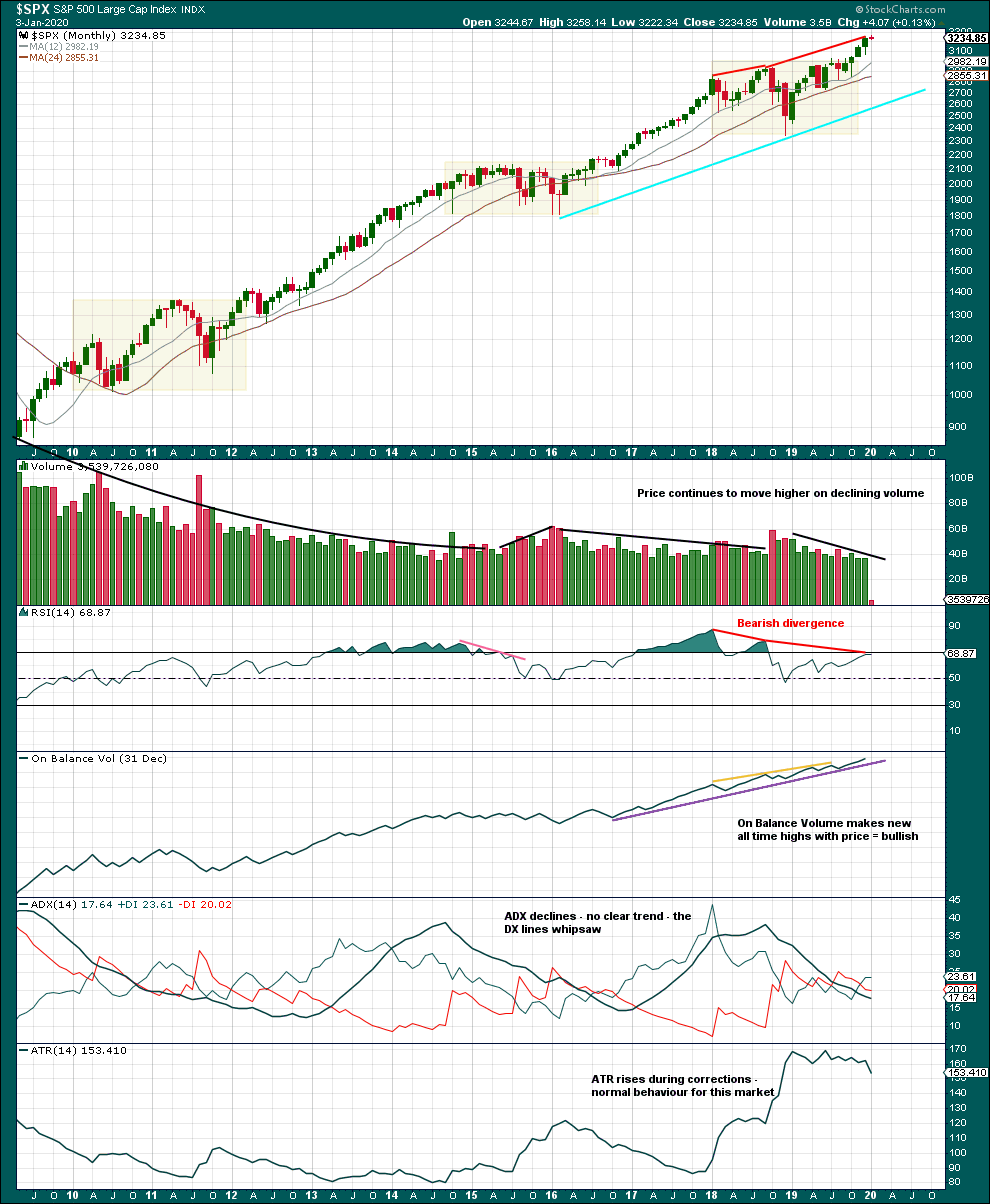
Click chart to enlarge. Chart courtesy of StockCharts.com.
There are three large consolidations noted on this chart, in shaded areas. After a breakout from a multi-month consolidation, it is reasonable to expect a multi month bullish move may result.
Note that in each of the first two cases a pullback saw price re-enter the consolidation zone after the breakout, before price then moved up and away. It is possible that may happen again after the last breakout from a consolidation.
This chart very clearly exhibits rising price on declining volume has now persisted for several years. A decline in volume last month, in current market conditions, is not of concern.
On Balance Volume supports the Elliott wave count.
WEEKLY CHART
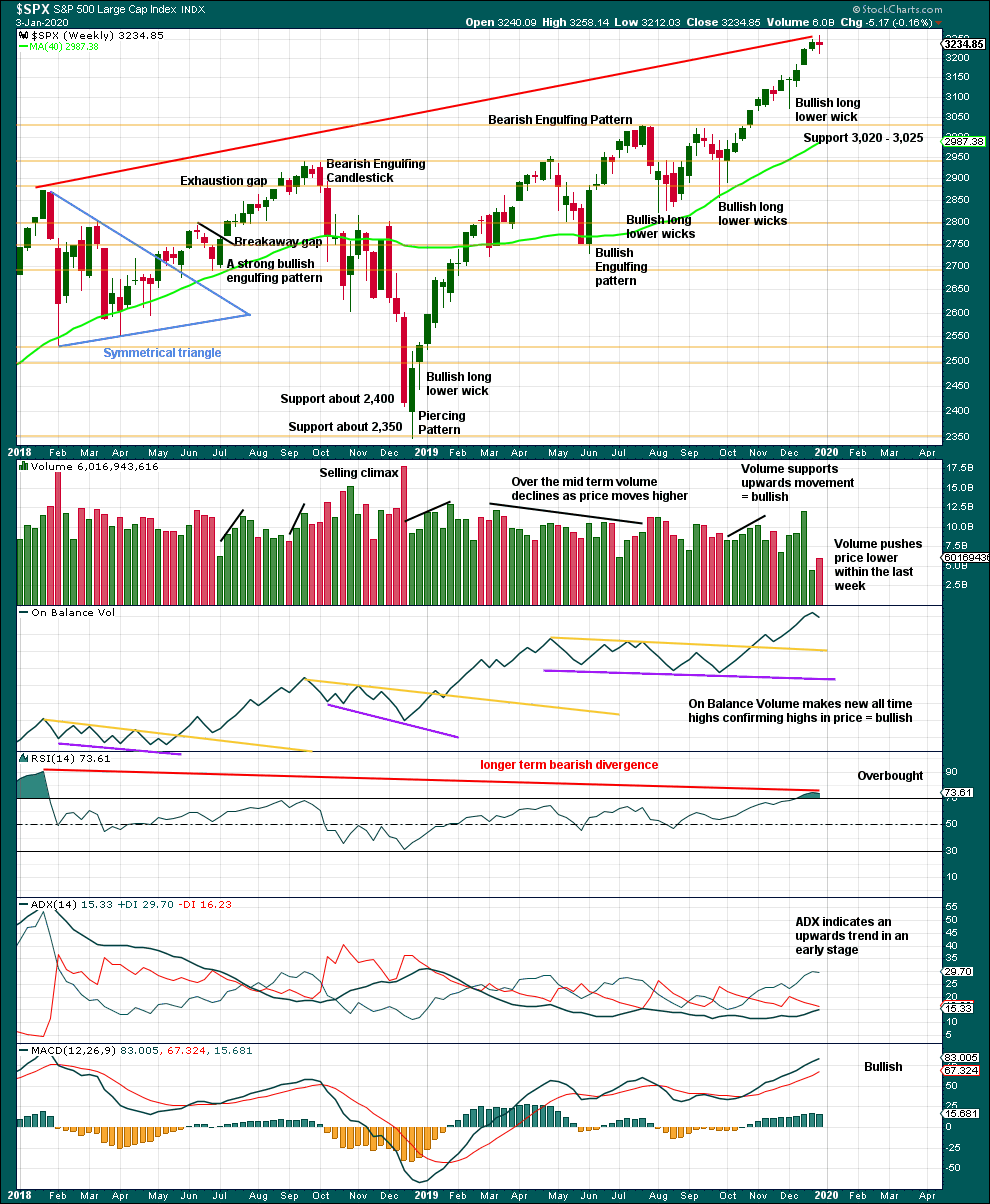
Click chart to enlarge. Chart courtesy of StockCharts.com.
It is very clear that the S&P is in an upwards trend and the bull market is continuing. Price does not move in straight lines; there will be pullbacks and consolidations along the way.
This chart is overall bullish. There are no signs of weakness in upwards movement.
RSI is now overbought. That does not mean upwards movement must end here, because it can continue for several weeks while RSI reaches more extreme. RSI reaching overbought is a warning that conditions are now becoming extreme. A pullback or consolidation will follow and the longer conditions are extreme the closer this will be. However, assume the trend remains the same until proven otherwise. This warning should be heeded by careful attention to risk management.
The doji this week on its own is not a reversal signal. It is a sign of a small pause.
DAILY CHART
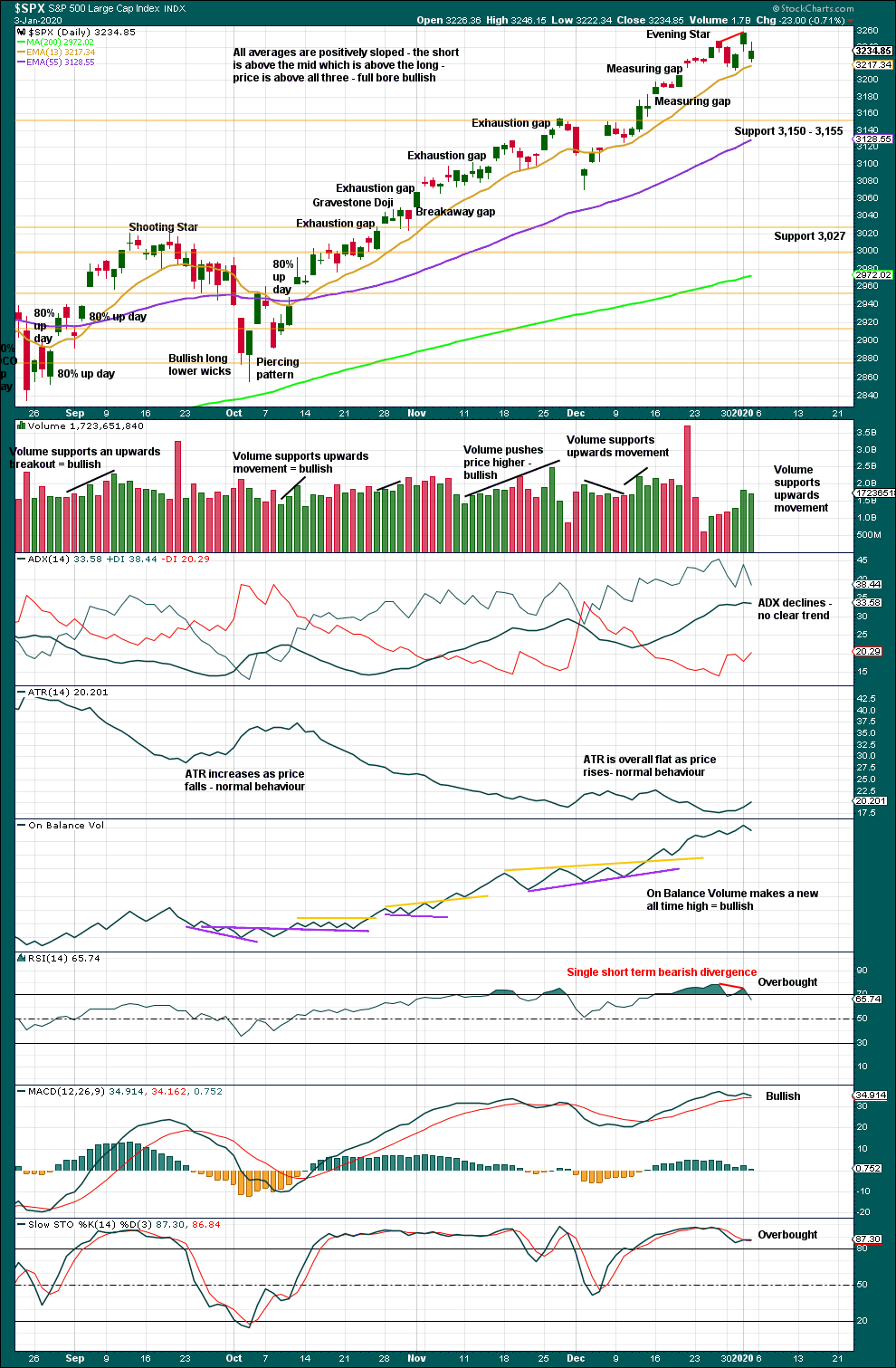
Click chart to enlarge. Chart courtesy of StockCharts.com.
There is an upwards trend in place. There will be corrections along the way.
Like the weekly chart, this chart is bullish.
RSI now exhibits bearish divergence while overbought. This is often (not always) a warning of a pullback or consolidation to develop.
BREADTH – AD LINE
WEEKLY CHART
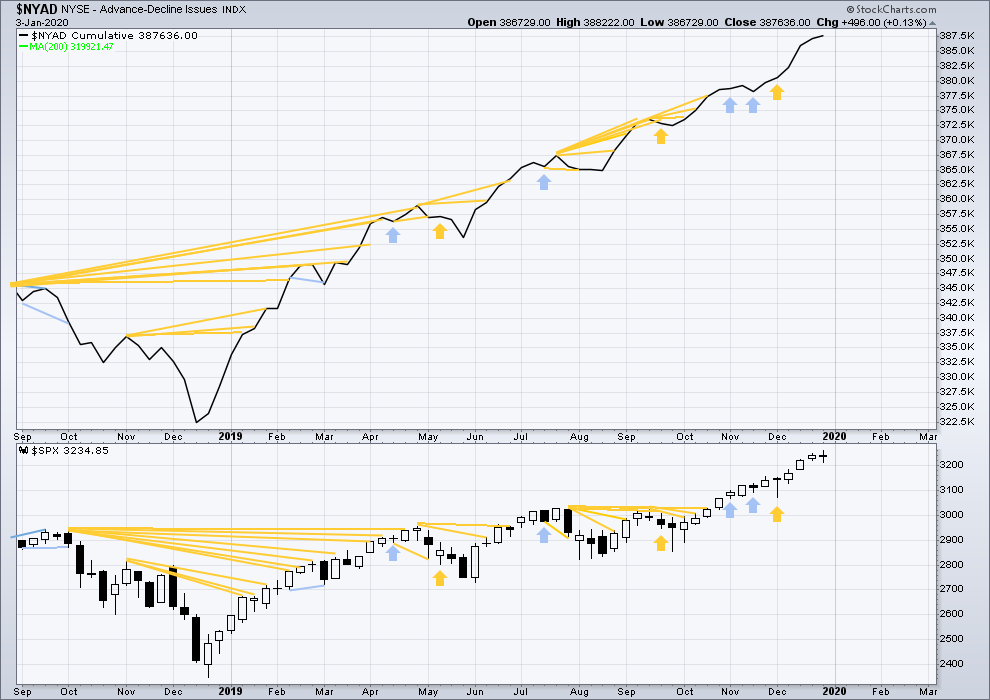
Click chart to enlarge. Chart courtesy of StockCharts.com. So that colour blind members are included, bearish signals
will be noted with blue and bullish signals with yellow.
Bear markets from the Great Depression and onwards have been preceded by an average minimum of 4 months divergence between price and the AD line with only two exceptions in 1946 and 1976. With the AD line making new all time highs last week, the end of this bull market and the start of a new bear market is very likely a minimum of 4 months away, which is the beginning of May 2020.
In all bear markets in the last 90 years there is some positive correlation (0.6022) between the length of bearish divergence and the depth of the following bear market. No to little divergence is correlated with more shallow bear markets. Longer divergence is correlated with deeper bear markets.
If a bear market does develop here, it comes after no bearish divergence. It would therefore more likely be shallow.
All of small, mid and large caps have made new swing highs above the prior swing high on the 13th of September, and mid caps have now made new all time highs. This upwards movement appears to be mostly driven by large caps, which is a feature of aged bull markets. This bull market at over 10 years duration certainly fits the definition of aged.
Again both price and the AD line have made new all time highs. There is no divergence. Upwards movement has support from rising market breadth.
Large caps all time high: 3,258.14 on 2nd January 2020.
Mid caps all time high: 2,073.72 on 2nd January 2020.
Small caps all time high: 1,100.58 on 27th August 2018.
DAILY CHART
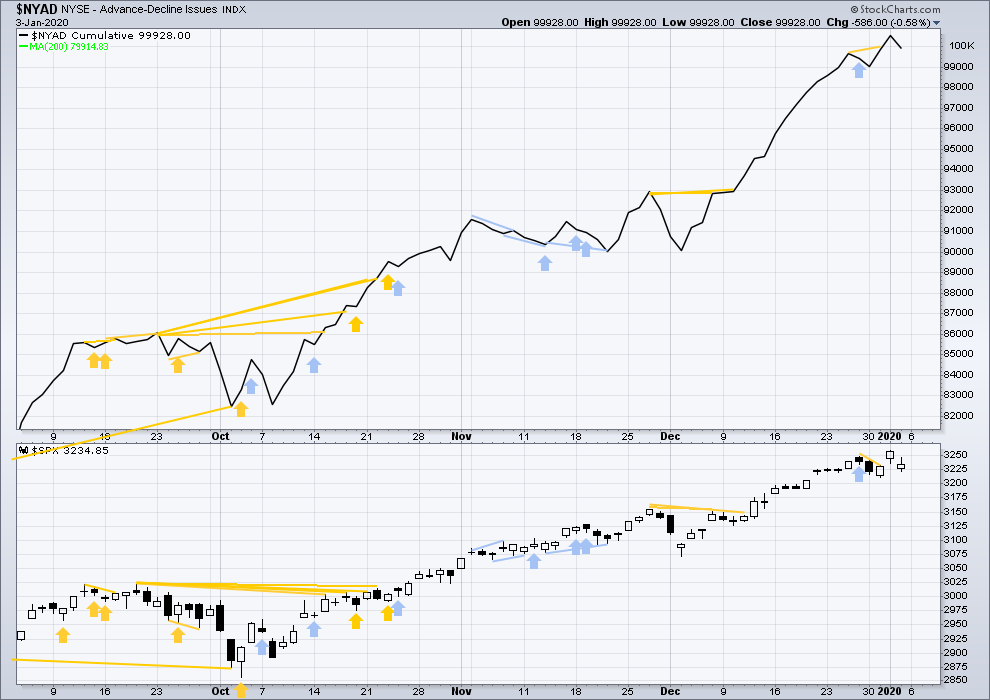
Click chart to enlarge. Chart courtesy of StockCharts.com. So that colour blind members are included, bearish signals
will be noted with blue and bullish signals with yellow.
Breadth should be read as a leading indicator.
Downwards movement on Friday comes with a normal corresponding decline in breadth. There is no new short-term divergence.
VOLATILITY – INVERTED VIX CHART
WEEKLY CHART
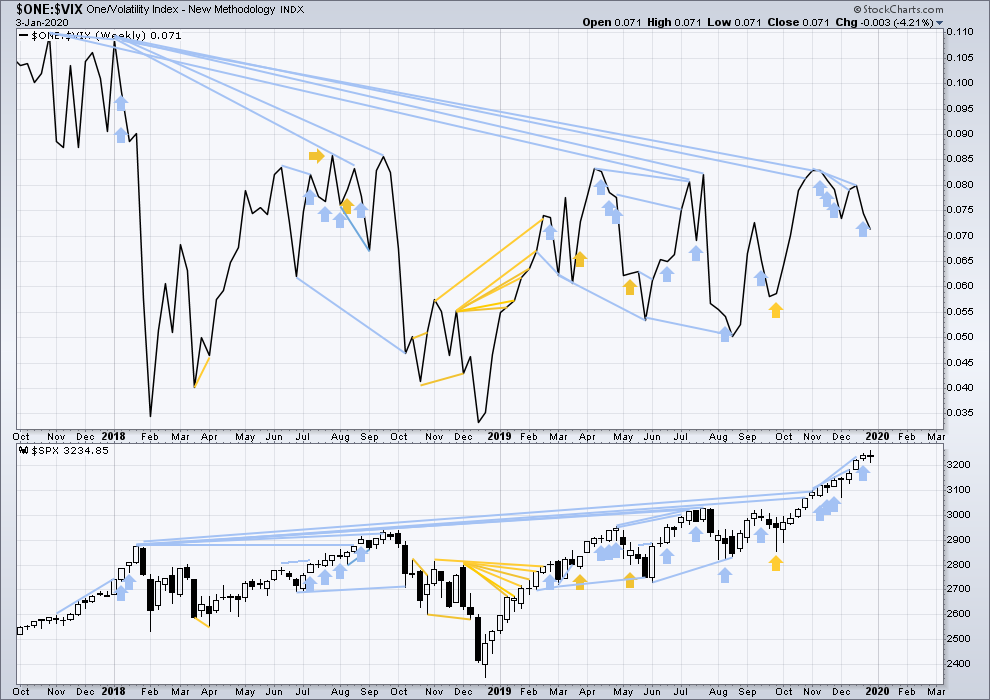
Click chart to enlarge. Chart courtesy of StockCharts.com. So that colour blind members are included, bearish signals
will be noted with blue and bullish signals with yellow.
The all time high for inverted VIX was on 30th October 2017. There is now over two years of bearish divergence between price and inverted VIX.
The rise in price is not coming with a normal corresponding decline in VIX; VIX remains elevated. This long-term divergence is bearish and may yet develop further as the bull market matures.
This divergence may be an early warning, a part of the process of a top developing that may take years. It may is clearly not useful in timing a trend change from bull to a fully fledged bear market.
This week completes an outside week. Inverted VIX has declined during the week. There is no new short-term divergence.
DAILY CHART
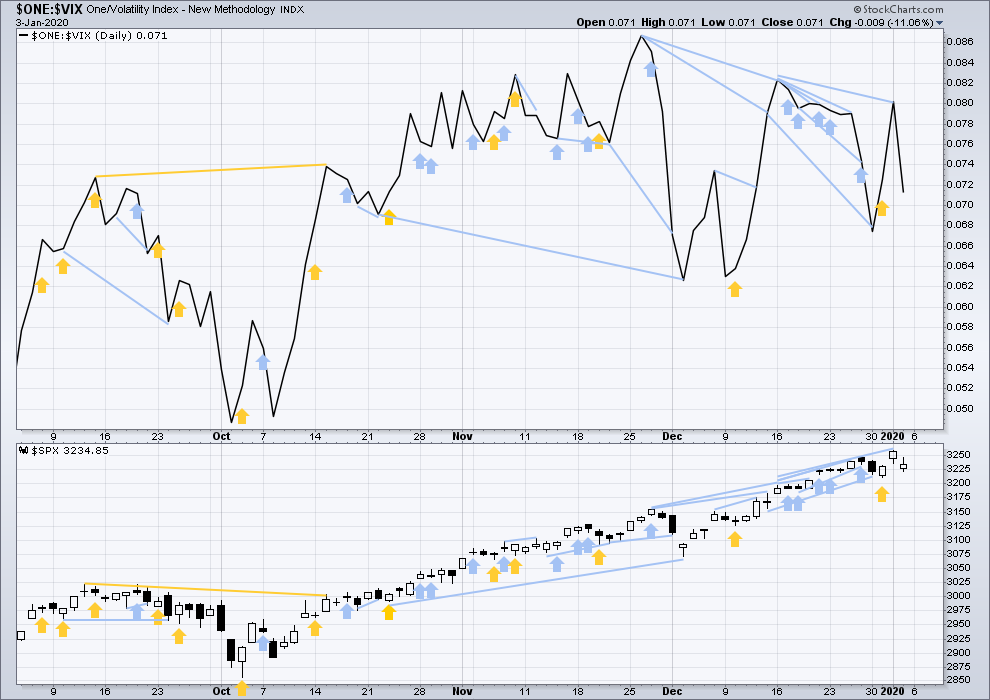
Click chart to enlarge. Chart courtesy of StockCharts.com. So that colour blind members are included, bearish signals
will be noted with blue and bullish signals with yellow.
Both price and inverted VIX have moved lower on Friday. There is now new short-term divergence. All of short, mid and long-term bearish divergences between price and inverted VIX remain.
DOW THEORY
Dow Theory confirmed a bear market in December 2018. This does not necessarily mean a bear market at Grand Super Cycle degree though; Dow Theory makes no comment on Elliott wave counts. On the 25th of August 2015 Dow Theory also confirmed a bear market. The Elliott wave count sees that as part of cycle wave II. After Dow Theory confirmation of a bear market in August 2015, price went on to make new all time highs and the bull market continued.
DJIA: 23,344.52 – a close on the 19th of December at 23,284.97 confirms a bear market.
DJT: 9,806.79 – price has closed below this point on the 13th of December.
S&P500: 2,532.69 – a close on the 19th of December at 2,506.96 provides support to a bear market conclusion.
Nasdaq: 6,630.67 – a close on the 19th of December at 6,618.86 provides support to a bear market conclusion.
With all the indices having moved higher following a Dow Theory bear market confirmation, Dow Theory would confirm a bull market if the following highs are made:
DJIA: 26,951.81 – a close above this point has been made on the 3rd of July 2019.
DJT: 11,623.58 – to date DJT has failed to confirm an ongoing bull market.
S&P500: 2,940.91 – a close above this point was made on the 29th of April 2019.
Nasdaq: 8,133.30 – a close above this point was made on the 26th of April 2019.
Published @ 10:00 p.m. EST.
—
Careful risk management protects your trading account(s).
Follow my two Golden Rules:
1. Always trade with stops.
2. Risk only 1-5% of equity on any one trade.
—
New updates to this analysis are in bold.

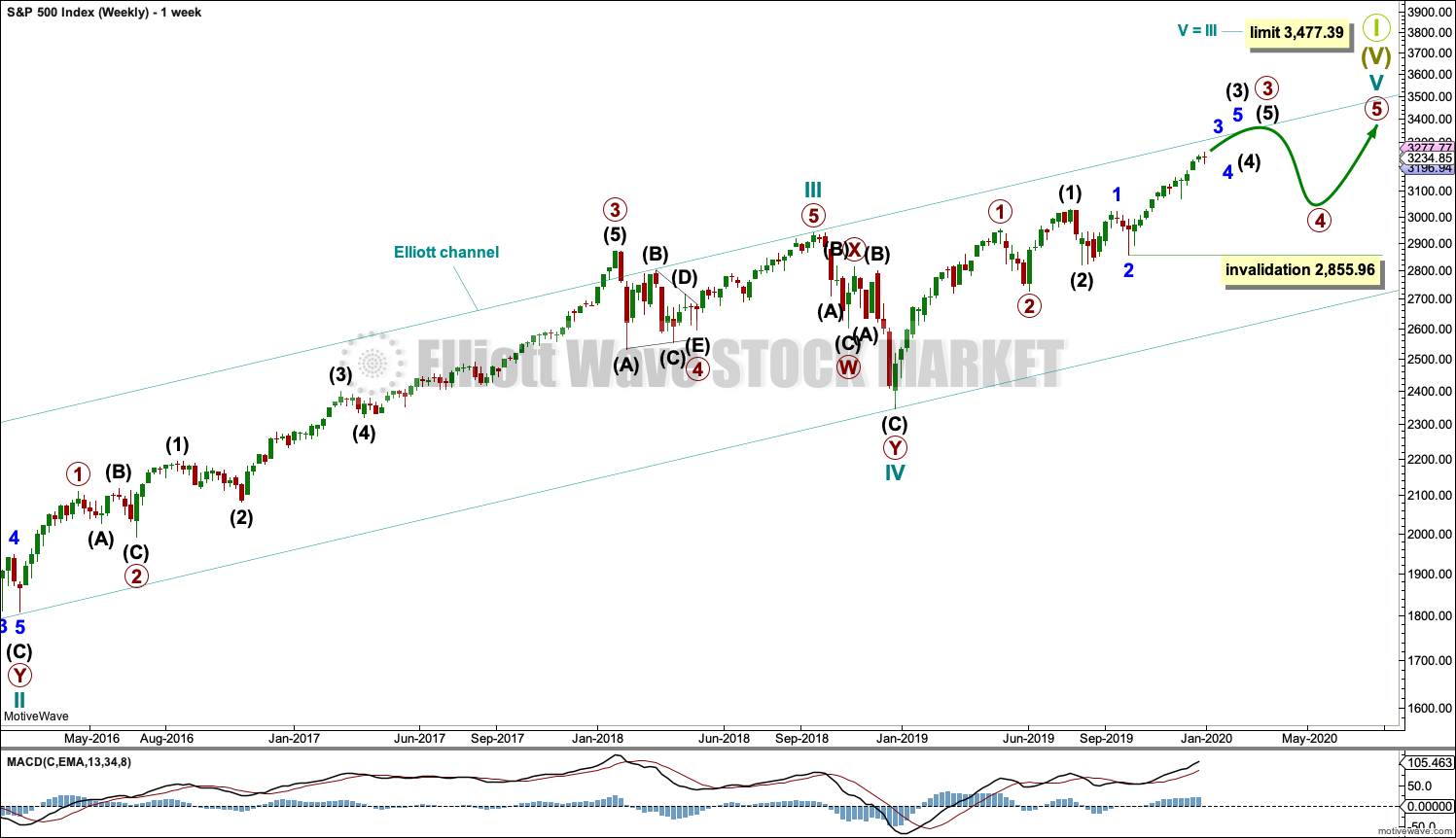
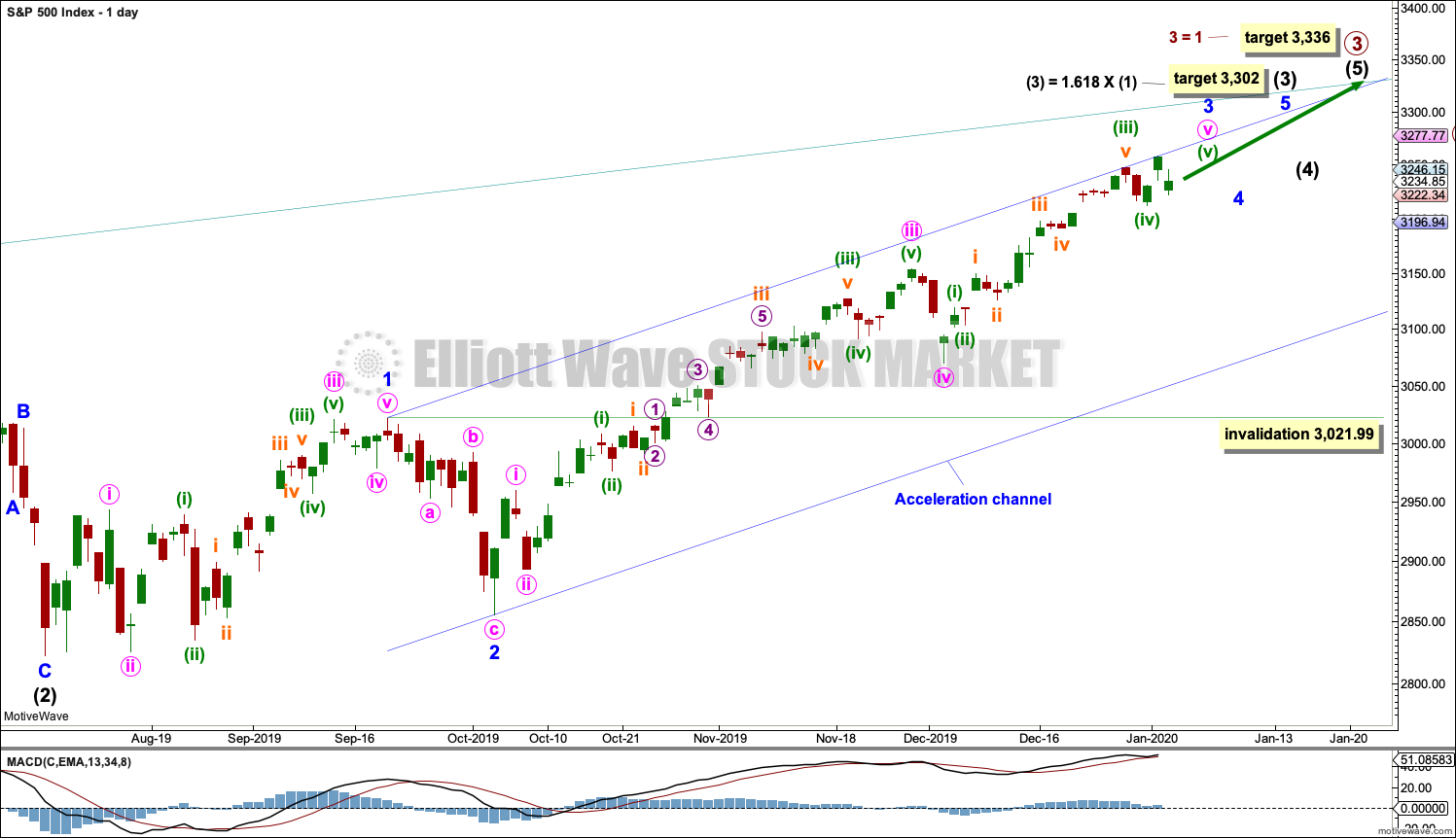
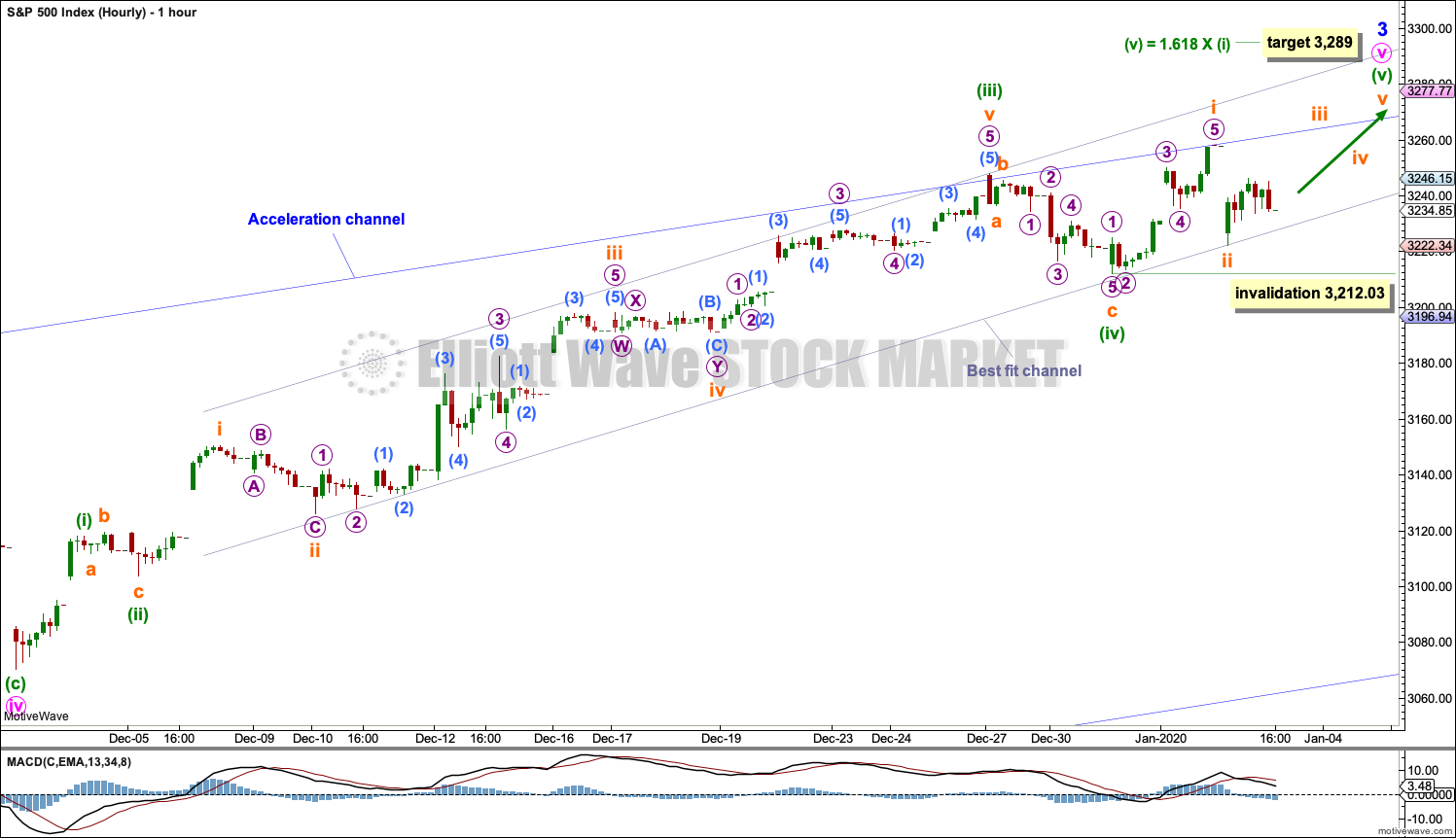
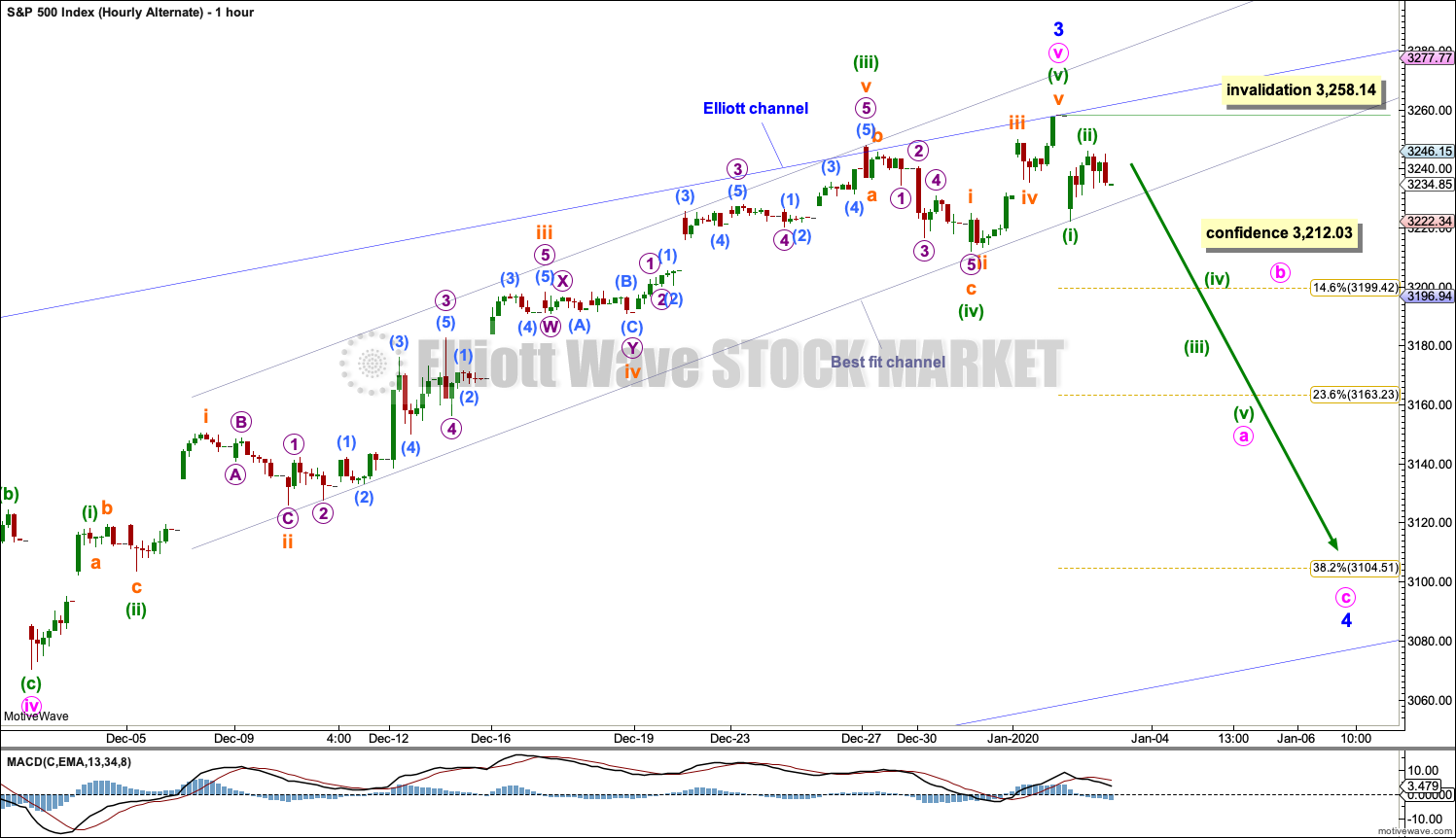
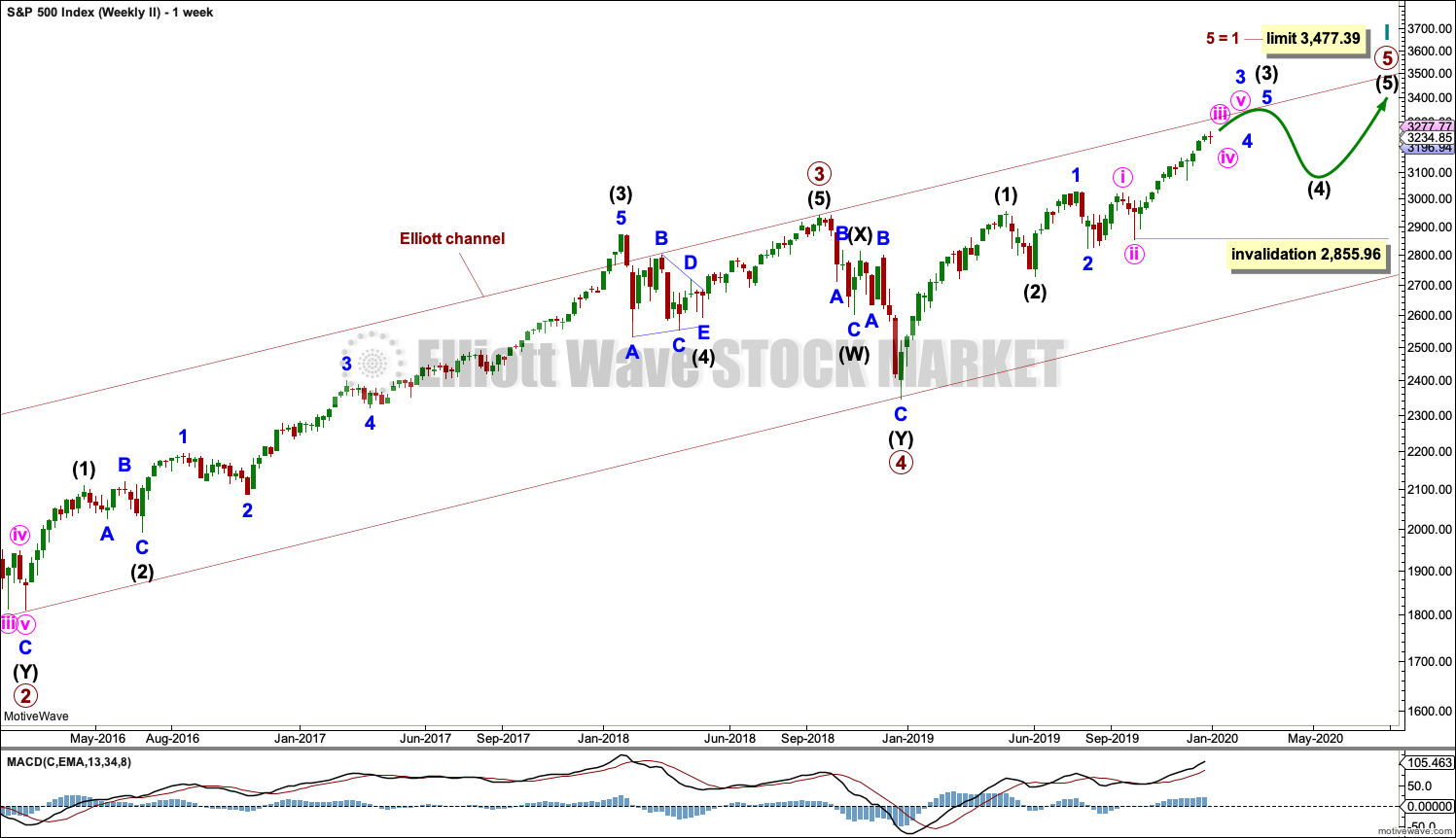
Possible head and shoulders forming (doesn’t mean it’s “likely”, just set up for it). Which dotted line track price follows is the question now. A slight variant of the H&S top scenario is of course a double top here. Two overhead targets for good fit: 3276 based only on the minute v, the two overlapped at 3297 based on the minute v and the whole minor 3 to date. The latter two overlap a prior swing 161.2% extension, making this level (3297) a very juicy target for a final minor 3->4 pivot high. I project that level arriving next Tuesday…if at all. But first…do we break past 3258 the recent ATH? Because that’s not the worst Fibonacci structure for the minor 3 and the minute v either (but definitely not as high fidelity as 3397 is).
The drama continues.
Main hourly chart updated:
The last move up subdivides as a five, followed by a three down which remained above the invalidation point. This remains the main wave count with a higher probability.
Alternate hourly chart updated:
This remains possible, but has a lower probability.
Hi Lara,
Is hourly alternate now invalidated as ii closed higher (at 3246.84) than (ii) which was 3246.15 or it is very close so it’s still a valid play?
Thank you.
Hmmm.
As Rodney has said, “surprises will be to the upside”, and today’s powerful reversal has been a bit surprising. I guess international turmoil and threat of epic conflict isn’t a problem for the Big Money, maybe even a feature? My oh my. But let’s see what the rest of the week brings.
We are in a quantitative easing period with lots of money on the sidelines yet. With QE prices for equities rise.
Noted. There were a 4 month steady rising market and then a 5 month steady rising market in 2017. This rising period is “only” into month 3 now. So yea…could be extending, extending, extending. The 8 period monthly squeeze firing off sure indicated a massive steady extended run up started 2 months ago, and so far so accurate. This is one of the challenge areas in EW: how to detect that a wave is completing versus extending and extending and extending? Answer: you have to assume extension and wait for CLEAR evidence of a pivot. Such as price here getting below the Dec 31 low and below the 21-23% retrace zone. I should have waited for that confirmation before establishing shorts; I didn’t, and now I’m likely to pay the freight for that error, unless the market suddenly decides to save me. Lesson for self: WHAT level you enter at is immaterial; WHERE the market is going is all that’s important, so there is NEVER a need to rush into trades. Always wait for STRONG confirmation, and always assume a trend in strong motion continues until that strong confirmation of change. You’ve taught me a lot today Rodney…
Looks like they ran stops in ES at 3246.12
Five down off the 3249.38 high…so far…
Hi Lara,
Can you please make available the video to get cash prices because I am working off FXCM future prices and according to this we have already breached your 3212 invalidation and touched 3206, so it makes analysis difficult.
Well it breached the channel but came back into it rather quickly.
3212 still not broken, no idea what to make of the action… i guess better to stay with the trend
you and me both, brother. Two days of big gaps down, following immediately by a strong push up and through said gaps. Churning before a bigger fall most likely? Or maybe not. It’s never easy, is it? Well, actually, most of this minor 3 has been easy, it’s FINISHING it that is proving challenging!
Here’s a short term short idea…the expected move lower target for Friday is 319.26. Weekly options pricing and the trading/hedging based on those prices tends to drive price to those expected move levels at some point during the week (very often at/near the end of the week).
So, a SPY put butterfly for Friday 1/10, 322/320/318. Max loss $25 per ‘fly, max win $170 per ‘fly. If if price heads the “wrong way”, you can probably get out for less than max loss. I’m in for a small bundle (along with much larger sold call spreads WAY overhead at 3300 in SPX…that’s my “very very likely” income! Did I mention I live my trading income? Yup. So consistency is everything to me, I can’t live off of butterflys, lol!! Far too inconsistent results. But I like ’em as side bets.)
On ES, looks like 5 down/3 up on the hourly chart with a big gap down on the open today.
On Friday price went below the equivalent of SPX 3212.03 at 3213 basis March ES.
Minor 4 seems to have arrived.
Indeed, it would appear that events have arrived to fulfill the wave count, one more time. Hard to believe given current world issues this market is going to keep marching up…but I suppose stranger things have happened. At the moment, the late last week weakness would appear to be continuing in the overnight session as you describe, and the stage continues to get set up for a larger correction to get rolling now. That would float a few of my boat$, for sure. Sell, baby, sell. Hoping for a close below Lara’s confirmation level tomorrow.
of course, war is always good for business…so maybe the latest developments aren’t so good for shorts! Hanging in the balance right now. Hopefully, just another kickback rally driven by the short term trading crowd fading the overnight gap down.
Bingo Bango!
Bongo …
Bzzzzt.